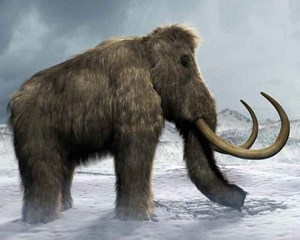To date a specimen, fragments of its DNA are compared to corresponding chunks from known descendants. Armed with a few evolutionary rules-of-thumb, scientists can calculate how long it would have taken for the observed mutations to arise. Analysis of this sort revealed that the youngest molar, found near a village called Chukochya, was between 500,000 and 800,000 years old. A tooth found near the Adycha river was from an animal that had died between 1m and 1.2m years ago. A third, found near another village called Krestovka, was dated at between 1.1m and 1.2m years. The previous record had been held by a set of horse DNA thought to be as much as 780,000 years old.
確定一個標本的年代要將其DNA片段與其已知后代的相應片段進行比較。科學家們借助一些進化經驗法則可以計算出觀察到的突變產生所需的時間。此類分析表明,在一個名叫楚科奇的村莊附近發現的最年輕的臼齒年齡在50萬至80萬歲之間。在阿德恰河附近發現的一顆牙齒屬于一種死于100萬至120萬年前的動物。第三個是在另一個叫做克列斯托夫卡的村莊附近發現的,它的年代在110萬到120萬年之間。此前的記錄是由一組馬的DNA保持的,這組DNA據有78萬年的歷史。

The teeth held other surprises. The Krestovka mammoth belongs to a previously unknown branch of the mammoth family tree, an ancestor of the Columbian mammoth which roamed North America 1.5m years ago. The Adycha mammoth was an ancestor of the iconic woolly mammoth. It appeared to possess many of its descendant's features half a million years earlier, suggesting the woolly mammoth's distinctive physiology evolved more slowly than had been thought.
這些牙齒還包含著其他驚喜。克雷斯托夫卡猛犸象屬于猛犸象家族的一個未知分支,該分支是150萬年前生活在北美的哥倫比亞猛犸象的祖先。阿德恰猛犸象是長毛猛犸象的祖先。它擁有其后代在50萬年前的許多特征,這表明長毛象獨特的生理進化速度比人們想象的要慢。
These are the sorts of insights into the slow workings of evolution that very ancient DNA can offer. And, it seems, prospects for collecting more such ultra-old samples are good. Permafrost has existed on Earth for the past 2.6m years. That puts an upper limit on the age of sequenceable DNA, but one that still leaves a million years more headroom. "I'm sure that in the permafrost there are going to be samples that have survived longer," says Patricia Pecnerova of the Swedish Museum of Natural History, and a co-author on the study. Records, after all, are made to be broken.
這些都是非常古老的DNA所能提供的關于緩慢進化過程的洞見。而且,收集更多這種超古老樣本的前景似乎很好。多年凍土在地球上已經存在了260萬年。這就給可測序DNA的年齡設定了上限,但仍留有100萬年的空間。瑞典自然歷史博物館的帕特里夏·佩涅洛娃是這項研究的合著者之一,她說:“我敢肯定永久凍土層中會有存活時間更長的樣本。”畢竟,記錄就是用來被打破的。
譯文由可可原創,僅供學習交流使用,未經許可請勿轉載。











